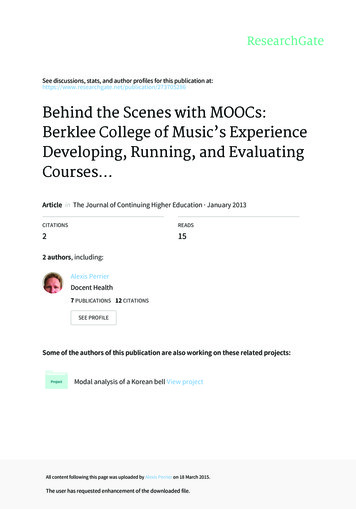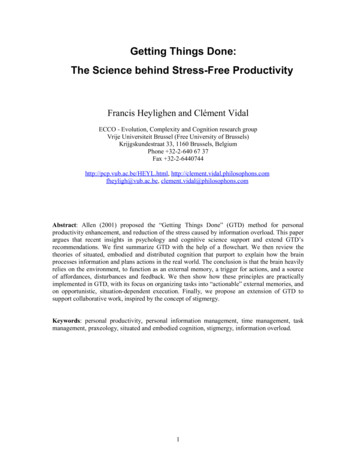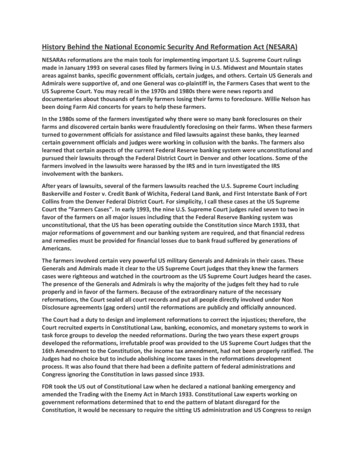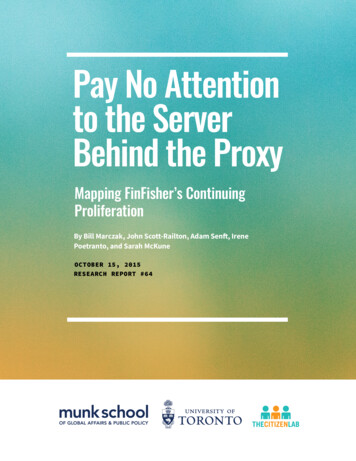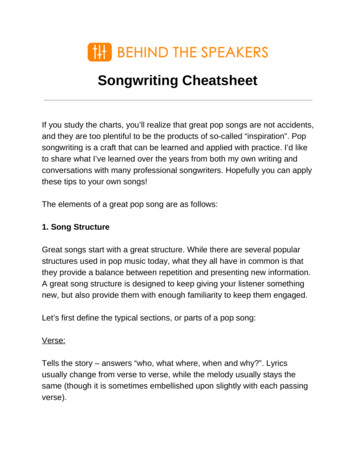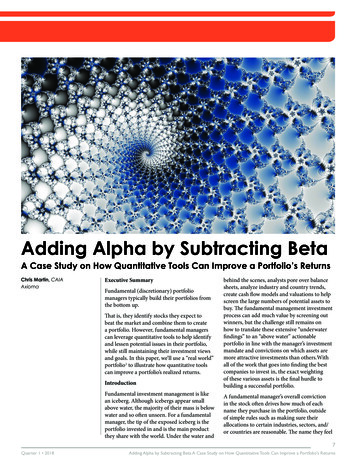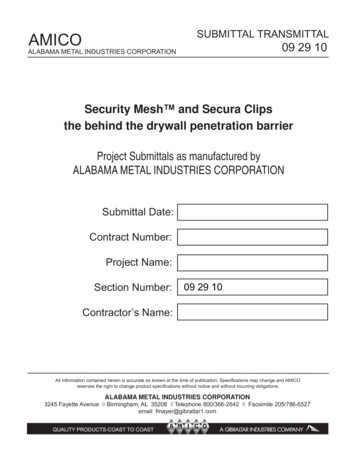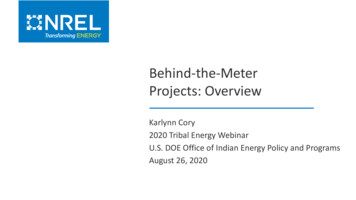
Transcription
Behind-the-MeterProjects: OverviewKarlynn Cory2020 Tribal Energy WebinarU.S. DOE Office of Indian Energy Policy and ProgramsAugust 26, 2020
Today’s GoalsBehind-the Meter (BTM) Power Projects– What they are– Why they are desirableIncentives, Net Metering, and other Policies– How they workHow to Scope Projects– Sizing of systems– EconomicsSolar photovoltaics (PV) business structures– Solar PPA or lease– Direct ownershipNREL 2
What is Behind-theMeter PowerGeneration?Generating power closerto the load avoidstransmission anddistribution losses and canincrease resiliency ifdesigned right1. Distributed generation (DG) is located on the distributionsystema) “Behind-the-meter,” on the customer side of the meterb) Interconnected to the utility distribution system, onthe utility side of the meter2. Utility-scale generation is interconnected to the utilitytransmission systemNREL 3
Behind the Meter Projects Provide: Energy cost savings,Control over project operations and maintenance,Self-consumption of distributed generation (usually solar PV),Visible commitment to sustainability (with solar PV), andResiliency (with battery storage).NREL 4
BTM Project Screening Best Practices Identify the relevant loadIdentify the project site Rooftop or ground mountCharacterize the solar resourceEvaluate technology optionsEstimate the economicsIdentify financing alternativesEngage your utility earlyNREL Technical Assistance is nical-assistanceNREL 5
Incentives,Net Energy Metering (NEM),and Other PoliciesState and utility policies can providesupport to all tribal projects.
Understand Potential IncentivesIncentive Provider Utility State Federal (tax credits only)Type of Financial Incentive Upfront amount ( or %) Performance-based (per kWh) Cash or tax credithttps://www.dsireusa.org/NREL 7
Net Meteringwww.dsireusa.org / June 2020DC40 States DC,AS, GU, PR, & USVIcurrently have mandatoryNet Metering rulesKEYState-developed mandatory rules for certain utilities (35 states DC 4 territories)In transition to statewide distributed generation compensation rules other than net metering (5 states)Statewide distributed generation compensation rules other than net metering (5 states)No statewide mandatory rules, but some utilities allow net metering (2 states)5 of these states are in transitionto policies other than net meteringU.S. Territories:ASPRVIGUNREL 8
Source: EL 9
NEMExcess GenerationBTM PV systems generallymeet the average annualload. Some months it willgenerate more thandemand and some monthsless. Treatment of excessgeneration is an importantNEM design element.Excess generation rolls over– Usually within one entire year– Sometimes within each month/billing periodAt end of year/month excess generation is either– Lost,– Credited/paid at avoided cost, or– Credited/paid at the retail rate.NREL 10
Source: EL 11
Source: EL 12
How to Scope Solar PVBTM Projects
Project Size ConsiderationsNeed to work within the NEM law Available roof space or ground space (slope, geotech) How big the system could be Site conditions (roof orientation, azimuth, and shading) How much power it can generate monthly, annually Size project at or below total on-site average annual load How much you can use– Typically at or below 100% average load (NEM laws)– Excess generation is Lost (Aim for project size smaller than 100% load), Paid/credited at avoided cost rate, or sometimes atretail rate ( 100% load)NREL 14
System EconomicsResidential Cost Over Time Cost decreasing over time Cost varies by state– CA buildings more energy efficient Residential systems aregenerally most expensiveRes. Cost and System Size by State, H2 2019– Not much economies of scale– Bulk purchasing can help Community systems are a bitcheaperSources: Source: EnergySage, “Solar Market place Intel Report H1 2019 – H2 2019.”and https://www.nrel.gov/docs/fy20osti/77010.pdfNREL 15
Solar PVBusiness Structures
Direct Ownership Immediate ownership and controlClear, visible commitment tosustainabilityCan use state/utility incentivesAll operations and maintenance(O&M) responsibilities Requires upfront cash/financingHigher financing rates than 3rdparties, but don’t pay 3rd partiesNo tax incentivesMust own the roof/landNREL 17
Solar PPAAdapted ustomer(consumer) buyselectricity fromsystem owner, as itis generated( /kWh)Renewable Energy Certificates (RECs)provided to utilityNREL 18
Solar LeaseCustomer(consumer) paysfixed, scheduledpayments to leasethe PV system( /month)Adapted from:https://www.nrel.gov/docs/fy10osti/46668.pdf ments.pdfRECs provided to utilityNREL 19
ComparingtheFinancingOptionsYes, if eligibleNoNoNoAdapted REL 20
U.S. DOETechnicalAssistance isAvailable1. Strategic EnergyPlanning2. Technical Analysis3. Financial AnalysisMore -assistanceApply for technical assistance.NREL 21
Free NREL Technoeconomic ToolsREopt Lite: RE model that examines economic viability,critical load outages, integration, and optimization Includes solar PV, wind, and battery energy systemsand will soon include CHP The user can enter your own input dataSystem Advisor Model (SAM): software model thatfacilitates project-level decision-making. Includes solar PV, solar thermal/process heat, highconcentration PV, wind, geothermal, biomass powergeneration, marine energy wave and tidal systems,solar water heating, and battery energy storage The user can enter your own input v/NREL 22
Thank you!www.nrel.govKarlynn CoryKarlynn.cory@nrel.govPhoto sources available upon requestThis work was authored by the National Renewable Energy Laboratory, operated by Alliance for Sustainable Energy,LLC, for the U.S. Department of Energy (DOE) under Contract No. DE-AC36-08GO28308. Funding provided by TheU.S. Department of Energy Office of Energy Efficiency and Renewable Energy Indian Energy Policy and ProgramOffice. The views expressed in the article do not necessarily represent the views of the DOE or the U.S. Government.The U.S. Government retains and the publisher, by accepting the article for publication, acknowledges that the U.S.Government retains a nonexclusive, paid-up, irrevocable, worldwide license to publish or reproduce the publishedform of this work, or allow others to do so, for U.S. Government purposes.
Source: NREL https://www.nrel.gov/docs/fy18osti/68469.pdfNREL 24
Community and Shared SolarLike NEM, butexpands themarket RentersMulti-familyhousingHomeownerswith unsuitablerooftopsMore information: ared-solarNREL 25
NREL 26
Aug 26, 2020 · System Advisor Model (SAM): software model that facilitates projectlevel decision- -making. Includes solar PV, solar thermal/process heat, high concentration PV, wind, geothermal, biomass power generation, marine energy wave and tidal systems, solar water heating, and batter

